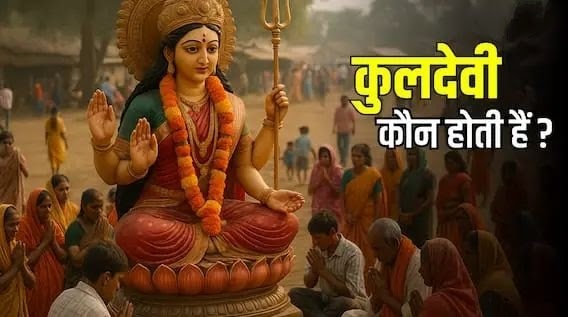In the religious and social life of India, the concepts of family deities and village deities were created not just for worship, but for identity, ancestor memory and security.
This is the reason why even today these rules are followed with complete discipline.
family deity, spiritual backbone of the lineage
Its origin has been explained in detail in the Vedic and Smriti texts. This tradition is not just for a few years but has been going on for hundreds of years, which is being transferred from generation to generation. Even in today’s modern era, no one has the courage to ignore them.
Traces of this tradition are found in the composition of deities with clans and ganas in the Rigveda. It is clearly stated in Manusmriti (3.203) that Kulsya rakshanartham tu kuldevataan samacharet. It means that the family deity should be worshiped for the protection of the lineage.
Similarly, in ancient texts like Yajnavalkya Smriti and Parashar Smriti, family deities have been considered as worshipable as ancestors.
Who is the family deity?
- Ishta or protector deity assigned to a particular Gotra, lineage or caste.
- They are identified by tradition passed down through generations, a family priest, or a family temple.
When and why to worship the family deity?
- Before rituals like marriage, mundan, housewarming, upanayana.
- In many homes, the idol and picture of the deity is kept and worshiped systematically.
Village Devi or Village God, the protector sitting on the border of the village!
Regarding its origin, widespread presence can be seen in tribal culture, Dravidian tradition and Puranas. There is mention of Grampal in Skanda Purana who protects the village from epidemics and evil forces.
Why is this puja necessary?
- To protect the village from rain, crop, epidemic, fire, famine.
- Special puja on Navratri, Chaitra month, Jatra and Amavasya.
Some famous forms of Gram Devi
| Area | Village Devi Name |
| North India | Shitala Mata, Bhairav Baba |
| Maharashtra | Jatra Devi, Khandoba |
| Tamil Nadu | Mariamma, Elamma |
| west bengal | Mansa Devi, Shoshi Devi |
What is the difference between family deity and village deity?
| Party | family deity or family deity | village deity |
| Produce | Vedic-Smriti tradition | folk-tribal tradition |
| relationship | Gotra, clan, lineage | village, regional society |
| method of worship | by the family priest | caste or region specific priest |
| Objective | Protection of lineage, values | Village security, prevention from disasters |
| puja time | Marriage, Upanayana, Housewarming | Annual fair, epidemic, new moon |
| place | family temple or home worship place | Village boundary, tree or platform |
religious meaning of both
- Totem: Protection and guiding power of ancestral spirits
- Village God: Protector against geographical, biological and social threats
To understand both is to understand one’s origin, tradition and social structure.
Why is this necessary in today’s times
- Even while living in today’s cities, people do not marry without visiting the Kuldevi.
- The tradition of fair, sacrifice and parikrama is still alive in the temples of Gramdevta.
- This is a wonderful confluence of folk power and scripture power.
Which planets are inauspicious by not worshiping the family deity or family deity?
- moon: mental disturbance, discord in the family
- Fortunate: hindrance in marriage and children
- Teacher: Deviation from religion, disturbance in values
- Saturn: Pitradosh, repeated failure, financial crisis
What are the effects?
- Frequent interruptions in marriage, children, job and home
- Unreasonable fear, bad dreams, disinterest in worship
- Family discord and disease across generations
But if someone does not know his family deity or deity, what to do?
- ask the elders
- Ask the oldest member of your family, like who was worshiped in our house before marriage?
- View old family pictures, temples, puja materials
- Many times the style of ancient pictures, statues, vermilion, flowers kept in the house indicate
- Ask the clan priest or Brahmin of the Gotra
- If the name of the patriarch of your Gotra or lineage is known, contact him.
- Visit the land of ancestors (original village)
- The main temple of the village located there and its god or goddess can often be your totem.
when nothing is known
If information is not available from all sources, the scripture advises-
- If the family deity is unknown, then Vishnu, Shiva or Goddess Durga can be worshiped as the presiding deity.
Dharmasindhu And in the Nirukta texts, there is an instruction that if the family deity is unknown, then the seeker should worship whatever god/deity he considers as his protector in his mind, in the form of family deity.
Why is this information important?
- Totems connect us to our identity.
- Village deities connect us to our community and geography.
- To know both of these is to know your roots.
It should not be forgotten that real India lives in villages. These are those strong traditions which inspire people to connect with their roots even in their fast-paced and busy lives.
FAQs
Q1. Does every clan have a different Kuldevi?
Yes, different Gotras or castes can have different family deities.
Q2. Can Gramdevi and Kuldevi be the same?
Sometimes the same goddess is worshiped in both forms in the village, but traditionally these are different.
Q3. Can one worship the family deity without knowing it?
No, worship is considered fruitful only with correct information and family tradition.
Disclaimer: The information provided here is based only on assumptions and information. It is important to mention here that NH does not endorse or confirm any information. Before implementing any information or belief, consult the concerned expert.
